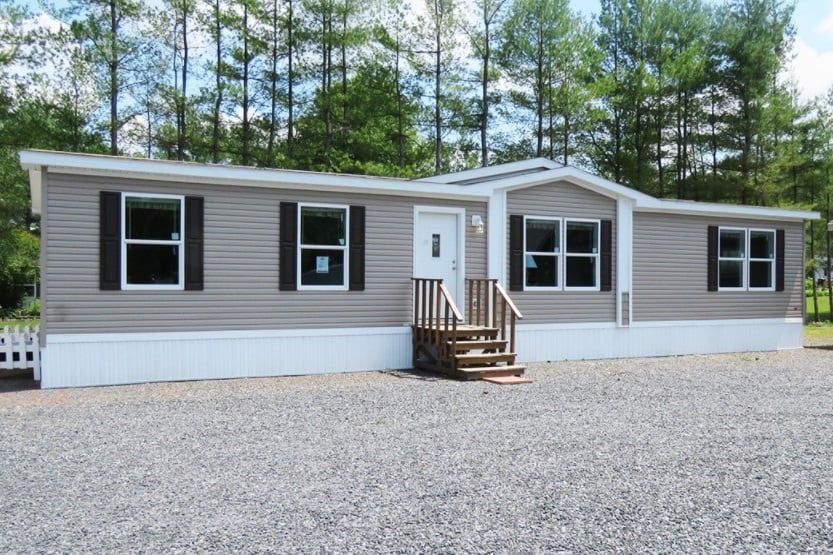The terms RV and mobile home are often used to describe one another. But technically, an RV and mobile home are quite different. RV vs mobile home – what is the difference between an RV and mobile home?
RVs are vehicles or camper trailers that are typically driven to different locations on a frequent basis for recreation. Mobile homes are housing structures that are towed to a site and kept at that site for the long term.
What is an RV? An RV (recreational vehicle) is a permanently motor-driven vehicle that requires registration through the Department of Motor Vehicles. The types of RVs include motorhomes, caravans, campervans, popup campers, truck campers, and fifth-wheel trailers. RVs are the definition of travel mobility.
What is a mobile home? A mobile home is a prefabricated structure built in a factory on a chassis and then towed to a site. Mobile homes need registration at the Department of Housing and Community Development. A mobile home functions the same as a stick-built house, except for the fact that you can move it to another location at will (but at a cost).
There are many other features for both that are unique. If you are planning on purchasing one or the other, you should consider all the features based on usage, lifestyle needs, and of course, budget allocation.
Read on to learn more about the differences between RVs and mobile homes.

RV vs Mobile Home
RVs are vehicles or camper trailers that are typically driven to different locations on a frequent basis for recreation. Mobile homes are housing structures that are towed to a site and kept at that site for the long term.
Some people might call an RV a mobile home. Few people would call a mobile home an RV. Both mobile homes and recreational vehicles (RV) offer downsized living situations. But they can be very different when it comes to features and offered amenities.
If you are currently looking for a scaled-down new home or just looking at options between RVs and mobile homes, then you have come to the right place.
To make it easy to compare the mobile home vs RV, below are tables outlining the pros and cons of each:
Recreational Vehicles (RV)
| PROS | CONS |
| Be your own landlord | High cost to buy brand new: $50k to $200k |
| Limitless mobility | Parking Fees: $30 to $50 per night |
| Many types to choose from depending on lifestyle needs, travel requirements, and budget | Unexpected costs (maintenance, repairs, and towing fees) |
Mobile Homes
| PROS | CONS |
| Cheaper to buy brand new: Single-wide: $48k~ Double-wide: $89k~ | High cost of moving: $1k to $15k |
| Offers more stability than RVs since it will be stationary for long periods | Dealing with landlords (for renters) |
| Lesser worries about unexpected costs (e.g., fluctuating gas prices, parking fees, and repairs) | Not as ‘mobile’ as an RV due to sheer size and built |
What Is an RV?
Recreational vehicles or more popularly known as RVs, are basically motor vehicles with complete basic living accommodation. There are several types of RVs based on features and inclusive functions. We will discuss them in detail later.
The United States and other countries have used the concept of an RV for centuries. In fact, explorations to North America, as early as 1745, used horse-driven caravans. And by 1810, France used wagons as an accommodation rather than just a form of transportation. RVs became even more popular in the 1920s when circus folk toured countries in wagons.
Fast forward today, RVs are the go-to vehicles of American families who want the convenience of having their home and vehicle in one.
RV uses can range from plain utilitarian with a basic kitchen and sleeping quarters to a lavish hotel-like accommodation complete with air conditioning, television, water heaters, and marble countertops. It usually depends on how much you’re willing to shell out on an RV.
Another key feature of an RV is how it runs. Some are considered as trailers (towed behind another motor vehicle), while others are self-motorized. In addition, some RVs can have a single deck, but the double-deck RVs are also a great choice, especially for campers. Most modern RV styles are more compact and now come with expanded sides called canopies or slide-outs.
Inverter on an RV – What Is It and How to Use It
Here are the different types of RVs:
1. Class A Motorhome (Bus Conversion)
These RVs are either built on a specially designed chassis (truck chassis) or a commercial bus chassis, making it a really heavy-duty vehicle. Most Class A RV designs look like a regular bus, usually having a flat or vertical front end.
Class A RVs have huge windows, which are sought-after by avid travelers who appreciate outdoor views. This RV type offers a wider living area due to slide-outs that you can use during stopovers or when the RV is in stationary mode.
2. Class B Motorhome (Campervan)
This type of RV, also called coach-built, is made by raising the roof on a standard van or replacing its low-profile body altogether. Different countries have varying interpretations of how a class B motorhome should be built.
Here are some examples:
Isuzu NPR 300 and Ford Trader
In Australia, a class B motorhome is bigger as it is built off a larger van type. These RVs can weigh as much as 4,500 kilograms, with about 6.4 meters in length.
Chassis: Chevrolet Express gas, Ford Transit, Benz Sprinter, and Dodge Ram ProMaster gas.

In Canada and the USA, the differentiating characteristic of a Class B motorhome is its chassis since it depends on the manufacturer. States in the US, such as California, have a specific set of rules for approving a vehicle as a Class B motorhome.
A vehicle must have 4 out of 6 of the following features to become a Class B motorhome in California:
- Cooking system
- Water system
- Air conditioning system
- Refrigerator
- Toilet
- 110-volt electrical system or fuel
3. Class C Motorhomes
Most Class C RVs run on automatic transmission powered by diesel, gasoline, or propane. Older versions were constructed using a wooden frame covered in a thin sheet of metal. But the structures of newer versions have plastics, composites, fiberglass, and other lightweight metals.
This type has a distinct cab-over profile containing a sleeping area, entertainment area, and storage space. It holds a kitchen and dining area complete with a fridge, microwave oven, and a table with seating. Other features include a bath shower, furnace, and water heater, including a generator, roof-mounted solar panels, and a sunshade.
Truck Camper
This type is useful for camping, fishing, backwood travel, and hunting. A truck camper is a great vehicle for part-time use and not for those who wish to live in a motorhome while traveling. It’s also best when driving to off-road campsites. The likes of Ford-250–350, Chevrolet/GMC 2500–3500, and Ram 2500–3500 are examples of truck campers.
Popup Camper
This one goes by many names – folding camper, tent camper, camper trailer, or tent trailer. As all these names suggest, this RV type is best for camping as it is very lightweight. The bunks and tent walls are collapsible and can be used for towing or storage.
Travel Trailer
These are rigid side designs towed by either a pickup truck, minivan, or SUV. They’re known in the UK as caravans. In previous years, big cars, such as GMC Suburbans and Ford Broncos, were used to tow travel trailers.
Teardrop Trailer
It is a more compact version of the travel trailer that resembles a teardrop, hence the name. You can tow this type of RV by car or motorcycle.
Hybrid Trailer
This one is a cross between a travel trailer and a folding tent trailer. It is available in two designs – a rigid side with a pull-out section that works as beds and an adjustable roof and wall for easier towing.
Fifth-wheel Trailer
As the name suggests, this one has a fifth-wheel coupling, a unique design for pickup or medium-size truck towing. Some fifth-wheel trailer RVs can extend to 40 feet (12.2 meters) long and weigh about 8,200 kilograms (18,000 lbs).
Park Model (Vacation Cottage)
This RV type is fairly large, about 35 to 45 feet in length, making it a great park camping vehicle. Its design is to be stationary for long periods due to its sheer size and hookup needs for added stability.
To know the difference between RV vs mobile home, read on to learn all about the mobile home.
Motorhome Classes – What Is a Class A, B, and C Motorhome?
What Is a Mobile Home?
Mobile homes are livable structures permanently attached to a chassis. You can transport it to a site of your liking too. Also called a trailer home or residential caravan, a mobile home is a great choice for people who enjoy having the option to move to another location at will while having the comforts of a complete home.
So, what’s the difference between an RV and a mobile home? You can use a mobile home as holiday accommodation, temporary housing, or even a permanent (but moving) home. Most mobile homes today are left permanently on a lot. But you can easily move it when required.
Like other recreational vehicles, this type of housing is preferred by others due to its mobility. You can travel from one state to another in a matter of hours without having to pack and unpack things like you would if you stayed in motels.
This convenience also had an overall positive effect on lifestyle and quality of life. At the start of the 1950s, it began to be marketed as an alternative housing solution that you can permanently install or easily move when needed.
Building Mobile Homes
As technological advancements arise, so did regulations and standards for safety and quality in building mobile homes. So from 1976 onwards, mobile homes were required to be made according to new and higher quality standards.
These larger, more permanent units were subsequently and legally referred to as ‘manufactured homes’ to distinguish them from smaller, mobile homes made before the HUD Code in 1976.

There are two most sought-after types of mobile homes: single-wide and double-wide.
- Single-wide: 18 feet (5.5 meters) wide by 90 feet (27 meters) in length
- Double-wide: 20 feet (6.1 meters) wide by 90 feet (27 meters) long, consisting of two separate units
Triple-wide as well as four, five, or more units are manufactured but are less common. Larger homes are not designed to be as mobile and are usually made to be fitted to a specific lot; so, becoming quite like a regular house.
Modern manufactured homes have features that can rival that of conventional housing. According to the US Census Bureau, a manufactured home costs about half the price per square foot compared to stick-built houses.
This fact greatly affects rental prices as well. You could expect that rental prices for a manufactured home with the same size as a three-bedroom and two-bath apartment are much less than a traditionally built house.
Other winning features of mobile homes, aside from its lesser price tag, are as follows:
1. Savings on Utility Bills
Manufactured homes usually follow energy-efficient federal rating standards, so you can be sure that utility bills, such as gas and power, will be significantly lower.
Additionally, lower usage means a smaller carbon footprint. Mobile homes are not only ideal for those working on a tight budget, as they are also perfect for individuals who deeply care for the environment.
2. Open Floor Plans
Today’s house hunters are younger, more open, and value space more than anything else. It is the reason why an open concept floor plan is one of the most wanted features in a manufactured home.
Open spaces tend to feel brighter and more spacious, letting in more natural light with higher ceilings. The seamless flow of open floor plans is perfect for the contemporary lifestyles of today.
3. Modern Style Kitchen and Bathroom
Purchasing a manufactured home comes with unlimited choices when it comes to fixtures and design. The possibilities are endless, from granite countertops to contemporary and energy-saving fixtures.
Modern styles tend to be more appealing to buyers. They increase the overall value of a manufactured home and help retain its value in the long run.
4. Extra Living Space
You have options for extra living spaces when you purchase a manufactured home. A welcoming front porch, a huge grilling deck, a storage shed, or an indoor garden are just some of the many possibilities open to those who like to live in mobile homes.
5. Planned Communities
It’s a fact that people want to live in a quiet, safe, and masterfully planned community. Such communities can offer designated walking, biking, and hiking trails, including swimming areas and a clubhouse to benefit the whole community.
Plus, people with the same love for living in mobile homes will surely enjoy a community built with their best interests in mind.
Differences Between Regular RVs and Modern Mobile Homes
Some of the obvious differences between a regular RV and a modern mobile home are as follows:
- RVs are more mobile and are permanently motorized. They require registration to the Department of Motor Vehicles.
- Modern designs of mobile homes have become so large that you can consider them as permanent housing; hence, their registration to the Department of Housing and Community Development.
- RVs are best for people who really enjoy traveling and who want to be on the move always. It is an extremely mobile option that can still provide adequate amenities for a comfortable living situation while on the road.
- Mobile homes are best for families that would like to stay in a specific location for longer periods of time, with the option of moving anytime they feel the need to.
Conclusion – What’s the Difference Between an RV and a Mobile Home?
RVs are vehicles that are driven to different locations on a frequent basis for recreation. Mobile homes are housing structures that are towed to a site and kept at that site for the long term.
The term RV generally serves as an umbrella term for any motorized vehicle with a living space’s basic amenities. There are many different types of RVs. They include popup campers, fifth-wheel trailers, and other mobile homes.
Mobile homes, for its part, have evolved from what a regular RV is supposed to look like. Today, mobile homes can give a luxurious, complete living space that some may already consider their permanent home. The best part of getting a mobile home instead of a conventional stick-built home is the cost. Plus, you will always have the option of moving your home to a different location when you feel like it.
Whatever you choose – mobile home vs RV – both have their own good and not-so-good qualities. Some of the best qualities seen in both RVs and mobile homes are:
- Mobility – You get to decide where you want to stay and for how long
- Cost – The fraction of the price of getting a stick-built house
- Modern Design – Offers the best in fixtures, comparable to conventional housing
Read next:






![Moped Vs Scooter [What Are the Differences Between Them?] moped vs scooter](https://roadsumo.com/wp-content/uploads/2021/06/moped-vs-scooter-150x150.jpg)

![Read more about the article Kawasaki Ninja 250 Top Speed [How Fast Can It Go?]](https://roadsumo.com/wp-content/uploads/2022/06/Kawasaki-Ninja-250-top-speed-300x200.jpg)
![Read more about the article Trailer Tongue Weight Scale [7 Best Scales]](https://roadsumo.com/wp-content/uploads/2021/03/trailer-tongue-weight-scale-300x200.jpg)